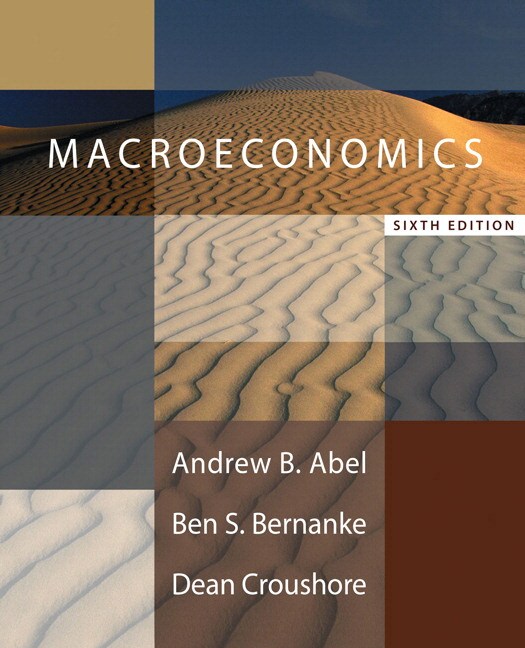Buy Macroeconomics, 6th Edition NOW

30.00$
Category : Higher Education
PART 1 INTRODUCTION Table of Contents
Chapter 1 Introduction to Macroeconomics
1.1 What Macroeconomics Is About
1.2 What Macroeconomists Do
1.3 Why Macroeconomists Disagree
Chapter 2 The Measurement and Structure of the National Economy
2.1 National Income Accounting: The Measurement of Production, Income, and Expenditure
2.2 Gross Domestic Product
2.3 Saving and Wealth
2.4 Real GDP, Price Indexes, and Inflation
2.5 Interest Rates
PART 2 LONG-RUN ECONOMIC PERFORMANCE
Chapter 3 Productivity, Output, and Employment
3.1 How Much Does the Economy Produce? The Production Function
3.2 The Demand for Labor
3.3 The Supply of Labor
3.4 Labor Market Equilibrium
3.5 Unemployment
3.6 Relating Output and Unemployment: Okun’s Law
Chapter 4 Consumption, Saving, and Investment
4.1 Consumption and Saving
4.2 Investment
4.3 Goods Market Equilibrium
Chapter 5 Saving and Investment in the Open Economy
5.1 Balance of Payments Accounting
5.2 Goods Market Equilibrium in an Open Economy
5.3 Saving and Investment in a Small Open Economy
5.4 Saving and Investment in Large Open Economies
5.5 Fiscal Policy and the Current Account
Chapter 6 Long-Run Economic Growth
6.1 The Sources of Economic Growth
6.2 Growth Dynamics: The Solow Model
6.3 Government Policies to Raise Long-Run Living Standards
Chapter 7 The Asset Market, Money, and Prices
7.1 What Is Money?
7.2 Portfolio Allocation and the Demand for Assets
7.3 The Demand for Money
7.4 Asset Market Equilibrium
7.5 Money Growth and Inflation
PART 3 BUSINESS CYCLES AND MACROECONOMIC POLICY
Chapter 8 Business Cycles
8.1 What Is a Business Cycle?
8.2 The American Business Cycle: The Historical Record
8.3 Business Cycle Facts
8.4 Business Cycle Analysis: A Preview
Chapter 9 The IS-LM/AD-AS Model: A General Framework for Macroeconomic Analysis
9.1 The FE Line: Equilibrium in the Labor Market
9.2 The IS Curve: Equilibrium in the Goods Market
9.3 The LM Curve: Asset Market Equilibrium
9.4 General Equilibrium in the Complete IS—LM Model
9.5 Price Adjustment and the Attainment of General Equilibrium
9.6 Aggregate Demand and Aggregate Supply
Chapter 10 Classical Business Cycle Analysis: Market-Clearing Macroeconomics
10.1 Business Cycles in the Classical Model
10.2 Money in the Classical Model
10.3 The Misperceptions Theory and the Nonneutrality of Money
Chapter 11 Keynesianism: The Macroeconomics of Wage and Price Rigidity
11.1 Real-Wage Rigidity
11.2 Price Stickiness
11.3 Monetary and Fiscal Policy in the Keynesian Model
11.4 The Keynesian Theory of Business Cycles and Macroeconomic Stabilization
PART 4 MACROECONOMIC POLICY: ITS ENVIRONMENT AND INSTITUTIONS
Chapter 12 Unemployment and Inflation
12.1 Unemployment and Inflation: Is There a Trade-Off?
12.2 The Problem of Unemployment
12.3 The Problem of Inflation
Chapter 13 Exchange Rates, Business Cycles, and Macroeconomic Policy in the Open Economy
13.1 Exchange Rates
13.2 How Exchange Rates Are Determined: A Supply-and-Demand Analysis
13.3 The IS—LM Model for an Open Economy
13.4 Macroeconomic Policy in an Open Economy with Flexible Exchange Rates
13.5 Fixed Exchange Rates
Chapter 14 Monetary Policy and the Federal Reserve System
14.1 Principles of Money Supply Determination
14.2 Monetary Control in the United States
14.3 The Conduct of Monetary Policy: Rules Versus Discretion
Chapter 15 Government Spending and Its Financing
15.1 The Government Budget: Some Facts and Figures
15.2 Government Spending, Taxes, and the Macroeconomy
15.3 Government Deficits and Debt
15.4 Deficits and Inflation
Appendix A Some Useful Analytical Tools
buy Macroeconomics, 6th Edition testbank , Andrew B. Abel, Wharton School of the University of Pennsylvania Ben S. Bernanke, Chairman of the Federal Reserve Dean Croushore, University of Richmond

Comments
Post a Comment